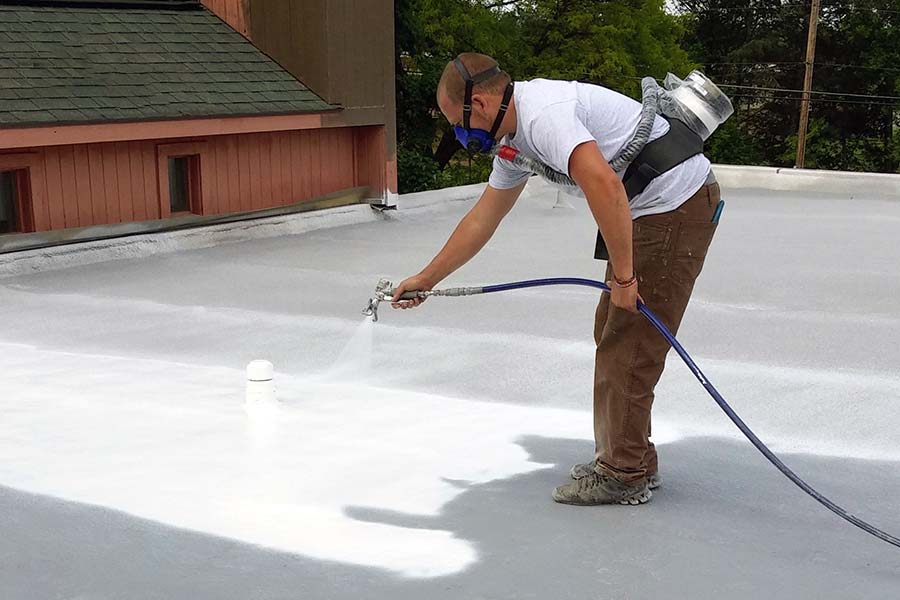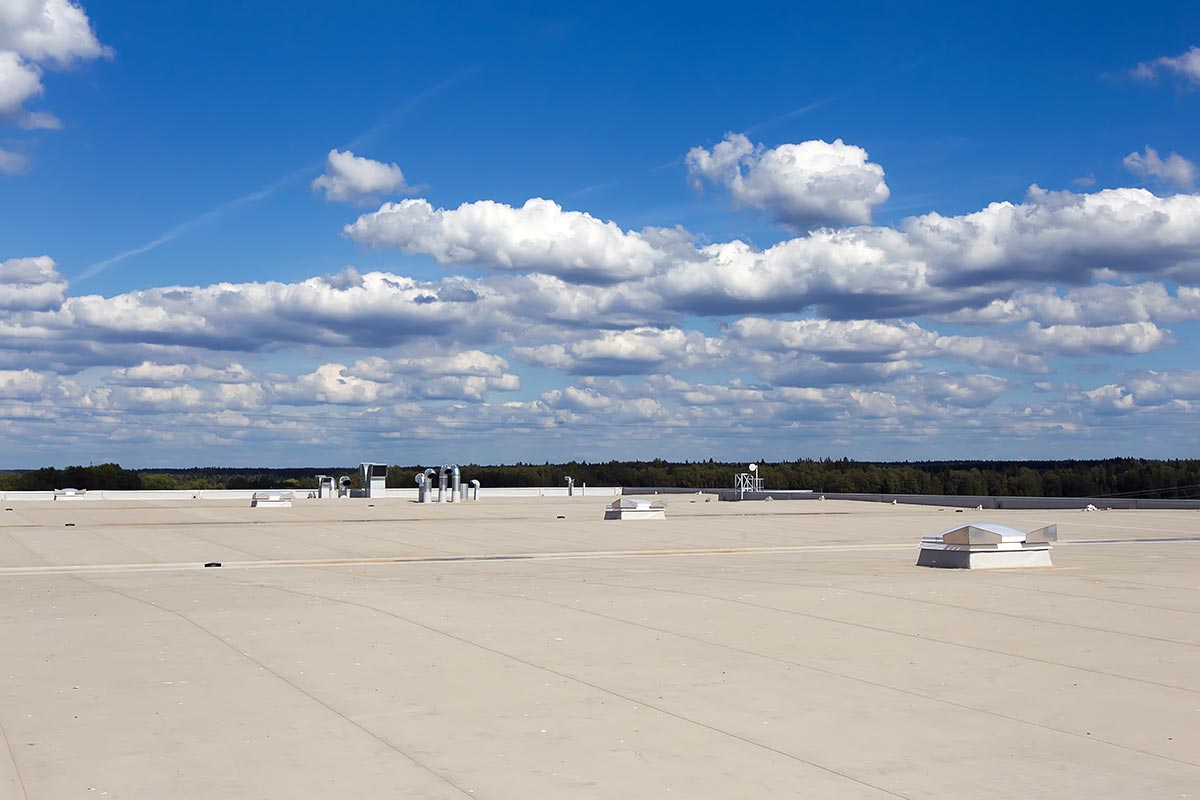
When it comes to longevity and performance, few commercial roofing materials are more impressive than spray polyurethane foam (SPF). Spray foam roofing systems are the best solution to increase energy efficiency and improve interior comfort. SPF possesses insulative and waterproofing qualities that simply cannot be matched by alternative commercial roofing materials.
In this comprehensive guide, we tackle a variety of topics surrounding this multifaceted material to help facility managers and property owners understand what SPF is and how it works.
Attention! If you have a spray foam roof in need of repair, click here to schedule a free evaluation with an American WeatherStar Approved Contractor.
What Is Spray Polyurethane Foam?
Spray polyurethane foam is a plural-component material created by blending isocyanate (A) and polyol (B) with heat and pressure. Chemicals A and B are sprayed in liquid form and react on contact to form a solid, lightweight, and fully adhered roofing membrane.
While spray foam has been around for a long time, it’s still relatively unknown to most facility managers and property owners. SPF has been used in various industries and applications since the 1940s, but it wasn’t until the late 1970s that it started being used in the roofing and building construction industry for its superior insulative qualities.
Modern spray polyurethane foam roofing materials come in open-cell and closed-cell grades. Closed-cell foam is primarily used in commercial roofing applications, while open-cell foam is typically used for interior insulation and soundproofing.
The Basics of Spray Foam Roofing
In spray foam roofing, the A and B components of SPF are blended and applied directly onsite with a specialized spray foam rig. The two chemicals, which are housed in separate containers, are pumped through high-pressure hoses to a mixing gun at a temperature of 115-130°F. To ensure a successful application, the proper amount of heat and pressure is imperative during the installation process.
As the foam cures, it solidifies to form a durable, seamless, lightweight, and waterproof membrane. SPF provides the highest R-value (the measure of thermal resistance) of any commercial roofing material and is suitable for use in nearly every type of climate.
The video below shows installers applying spray foam to various types of commercial roofing substrates.
Foam Density
The B component is what determines the density of the foam. To be strong enough for use in a commercial roofing application, the foam must have a density of at least 2.5 psi (pounds per square inch). Generally, a density of 2.7–3.0 lbs. is needed for the foam to be rigid enough to walk on. Anything lower than a density of 2.5 lbs. is too soft to walk on without damaging the foam.
UV Performance
While SPF is an outstanding waterproofer and insulator, it offers little to no protection against the sun’s UV rays. To combat this problem, the foam must be coated with an elastomeric roof coating (e.g., silicone, acrylic, urethane, butyl rubber) to achieve the necessary level of UV protection.
Based on SPFA guidelines, we recommend a minimum of 20 mils of silicone coating. In certain cases, as much as 40 mils may be required—depending on the chemistry used and warranty requirements. Visit www.sprayfoam.org for more information on the application of SPF and roof coatings.
Recommended Reading: Which Roof Coating Performs Best?
Finding the Right Contractor
The installation of an SPF roofing system requires a great deal of knowledge of SPF chemistry and the use of highly specialized application equipment. For some contractors, it can take months or even years to become a proficient SPF roofing system applicator.
For those considering an SPF roofing system, take the time to properly vet potential contractors. Request to see job references, industry certifications, product samples, case studies, etc. In some cases, a contractor may be able to arrange a roof walk on a project they recently installed.
The Pros of Spray Foam Roofing
Thermal Resistance (R-Value)
Spray foam roofing insulation has the highest R-value of any conventional roofing material. R-value measures a material’s ability to resist the flow of heat. The higher the R-value, the better the insulator. The R-value of roofing-grade SPF is approximately 6.5 per inch. However, it is widely held that SPF provides far greater insulation qualities than its R-value suggests.
Strength & Durability
Spray foam systems provide commercial roofs with an incredibly strong, yet remarkably lightweight, protective membrane. In fact, SPF systems, applied at a thickness of 1 inch or greater, are proven to enhance a building’s structural integrity.
Longevity
A properly installed and maintained SPF roofing system can last 30 to 40 years, if not longer. SPF systems must be recoated every 10 to 15 years to ensure the long-term performance of the system by not allowing the sun’s UV radiation to degrade the foam layer.
Seamless & Self-Flashing
Unlike conventional roofing systems, spray foam roofs are completely seamless and self-flashing. SPF is specially designed to conform and adhere to irregular shapes and surfaces. These qualities virtually eliminate the ability for water to enter sensitive areas of the roof such as seams, fasteners, penetrations, and other flashing details.
Ease of Maintenance
SPF roofing systems are easy to maintain. Minor damage can usually be repaired with roofing-grade mastic or specialized roof sealant. If the damage is severe, however, extensive repairs are going to be required to ensure that the system remains watertight, and the foam membrane is not exposed.
In any case, we highly recommend consulting with an experienced spray foam roofing contractor to conduct regularly scheduled roof maintenance inspections.
Quickly Installed
Compared to most other conventional roofing materials, SPF systems can be installed more quickly and are far less disruptive to building occupants. That’s because spray foam systems are applied directly to roof substrates and don’t typically require the removal of any existing roofing material.
Renewable & Sustainable
Because SPF roofing systems can be recoated numerous times, they produce little to no waste over the course of their lifespan. This offsets the landfill waste concerns and high costs that normally accompany a roof tear-off and replacement.
The materials that comprise spray foam roofing systems are also environmentally friendly.
The Cons of Spray Foam Roofing
Application Equipment
The application equipment for SPF materials is very expensive. While most roof coating spray rigs cost $10,000–$20,000, a spray foam rig—which includes an air compressor, generator, and enclosed trailer—can cost upwards of $100,000. Constant maintenance is also needed, and the parts can be difficult to access quickly when issues arise.
Note: Though we do not sell or maintain spray foam equipment, we do recommend Spray Works Equipment to contractors looking to offer spray foam solutions to their customers. Visit www.sprayworksequipment.com to learn more.
Up-Front Cost
Cost-wise, spray foam roofs are comparable to many other commercial roofing systems, however, they are significantly more expensive than standard roof coating systems. SPF systems can cost anywhere from $5.00 to $8.00 per square foot, or more, depending on the roof size and required application thickness of the SPF material. There are a variety of other factors to consider, as well.
Limited Application Window
SPF roofing systems must be installed when temperatures are above 50°F and when humidity levels are relatively low. Depending on the region and time of year, this can delay or even prevent the installation of spray foam roofing systems.
UV Exposure
The primary cause for spray foam system failures is UV exposure. Though SPF is an incredibly sturdy material, it is not designed to withstand prolonged exposure to the sun. This issue usually results from poor installation or lack of maintenance. Routine service and recoating the foam layer every 10 to 15 years are the only surefire ways to avoid premature system failure.
Contractor Experience
When it comes to installing spray foam roofing insulation, not all contractors are created equal. Working with spray polyurethane foam requires a high degree of product knowledge and the use of sophisticated application equipment and techniques. Those considering an SPF roofing system must practice due diligence in order to find a properly trained SPF roofing contractor.
Overspray Potential
There is always going to be the potential for overspray when spray applying foam. One of the greatest strengths of SPF is its adhesive qualities. While that’s good for the roof, it’s not good for other surfaces that it may encounter nearby (e.g., automobiles, neighboring structures, landscaping).
Spray foam can carry great distances on a windy day. If the wind is blowing harder than 10–15 mph, contractors use a wind shield to reduce the chance of overspray.
Spray Foam Roofing Cost
As previously mentioned, spray foam roofing costs anywhere from $5.00 to $8.00 per square foot. These figures depend mostly on the thickness of the foam and the size/complexity of the roof structure. There are also other factors to consider such as location, condition of the existing roof substrate, top coating material, type of warranty, etc.
It’s worth mentioning that SPF systems are proven to significantly reduce a building’s energy cost, thus providing a much faster return on investment.
In the table below, we compare the approximate costs (labor and material) of spray polyurethane foam roof systems to other commonly used commercial roofing materials:
| System/material | Low-end cost (per sq. ft.) | High-end cost (per sq. ft.) |
|---|---|---|
| SPF | $5 | $8 |
| Built-up | $6 | $14 |
| EPDM | $4 | $10 |
| Metal* | $3 | $15 |
| Modified bitumen | $5 | $12 |
| PVC | $5 | $12 |
| TPO | $4 | $10 |
| Roof coatings | $2 | $5 |
Suitable Roofing Substrates
Foam roofing insulation is a highly versatile material that is suitable for a variety of commercial roofing substrates including:
- Built-up roofing
- Modified bitumen
- EPDM (with cover board)
- PVC (with cover board)
- TPO (with cover board)
- Metal
- Concrete
The type of roofing substrate is not as important as its condition. At a certain point, commercial roofs can exceed the window for which an SPF system is an appropriate solution. We strongly recommend an infrared survey be performed on most substrates to ensure the roofing assembly isn’t too saturated.
SPF Roofing Installation Process
For an average size commercial roof (20,000 sq. ft.), the time needed for contractors to install a spray foam system is about 2 weeks—weather permitting. Generally speaking, the installation process can be broken down into four basic steps:

1. Surface Preparation
First, the existing roof substrate is pressure washed to remove all dirt, dust, debris, and other foreign contaminants. This will ensure maximum adhesion of the foam to the underlying material. In some cases, a primer is needed to achieve proper adhesion.
Note: For more information on the proper adhesion of roofing spray foam, click here to speak with an American WeatherStar technical services representative.
2. Spray Polyurethane Foam
Next, spray polyurethane foam is applied to the roof surface at a minimum thickness of 1 inch, although it can be sprayed at greater thicknesses to increase insulation value. It can also be used to taper (create slope) around certain areas of the roof to ensure positive drainage.
3. Elastomeric Roof Coating
As previously mentioned, SPF roof systems must be top-coated with an elastomeric roof coating to prevent UV degradation. This coating application is done in multiple passes to ensure uniform mil thickness and even coverage.
For SPF systems on steep-slope roofs, acrylic coatings are most commonly used. For flat (low slope) roofs, silicones or urethanes are preferred as they are better suited to withstand ponding water.
4. Roofing Granules
Finally, #11-grade roofing granules are broadcast into the elastomeric top coat. This gives the system added strength, durability, UV protection, and resistance to wildlife. American WeatherStar requires the addition of roofing granules to SPF systems in order to qualify for an NDL warranty.
Note: To ensure quality and consistency standards, American WeatherStar Approved Contractors are required to follow specific Application Guidelines during system installs. These documents provide a step-by-step outline of the system installation process over a particular roofing substrate.
Spray Foam Roofing Maintenance
Committing to a routine maintenance plan is a good strategy for any commercial roof. For spray foam roof systems, it’s especially important. Although spray foam is a highly durable substance, it’s rather susceptible to damage from hail, accidental punctures, wind-driven debris, pedestrian traffic, etc.
The goal of any roof maintenance program is to catch small problems before they become big ones.
As previously mentioned, spray polyurethane foam will break down rather quickly if exposed to the sun for too long. If left unaddressed, the foam membrane will essentially burn away and eventually lead to a much more extensive repair project or worse—a complete system failure.
The best time to perform maintenance on an SPF roof is in the spring and fall. This enables the system to be better prepared for the severe weather that normally accompanies the summer and winter months.
It is also recommended to conduct impromptu inspections immediately following significant weather events to ensure the foam and coating membranes remain intact.
Note: If a service contractor, specifically an HVAC Technician, needs to access and walk on a spray foam coated roof, take precautions to avoid unintended damage. Something as simple as a dropped tool or piece of equipment can easily puncture both the foam and coating membranes. If possible, arrange for a spray foam roofing contractor to survey the roof surface immediately following service appointments where roof access is required.
Repairing an SPF Roofing System
Only experienced professionals should conduct a spray foam roofing repair. The longevity of an SPF system is mostly dependent on the condition of its foam layer, so it’s imperative to consult with a specialist to ensure that the foam hasn’t been compromised.
For minor damage, application of a roofing-grade mastic or sealant is usually all that is needed. These products are specially designed to bridge gaps and fill holes. It’s important to use the correct type of product when repairing a spray foam system. For SPF roofs with a silicone top coat, only a silicone-based mastic or sealant will provide the right level of adhesion.
In cases of severe damage, in which the foam membrane has become UV-damaged or saturated, more extensive repair methods are needed. Any damaged foam must be removed with a scarify grinder in order to reach uncontaminated foam. These areas are then primed to ensure the new foam application (minimum of 1 inch) will stick to the existing foam membrane.
Once the damaged areas of spray foam are corrected, multiple coats of an elastomeric roof coating are applied. Roofing granules are then broadcast into the top coat for added UV protection and durability.
Recoating a Spray Foam Roof
Spray foam roofs can last up to 30 years or more if properly installed and maintained. In order to achieve that kind of longevity, SPF systems must be recoated every 10–15 years depending on the type of coating and mil thickness applied.
The SPF recoat process includes:
- Repairing any UV-damaged and/or saturated foam
- Cleaning the entire roof to remove dirt, dust, debris, and other foreign contaminants
- Priming to ensure proper adhesion (if necessary)
- Applying additional coats of the same chemistry originally used
We offer both Material and NDL System warranties for spray foam recoats. A detailed inspection of the existing SPF system—including an infrared survey—by an American WeatherStar Approved Contractor is required in order to qualify.
For more information on SPF recoats, click here to speak with a Technical Services representative.
Foam-Gard (SPF + Roof Coating System)
Foam-Gard is a premium spray polyurethane foam roofing system exclusively from American WeatherStar. It’s designed to restore and protect a variety of commercial roof substrates and comes backed with 10, 15, and 20-year Material or NDL (no dollar limit) System warranty options. Foam-Gard also has numerous industry approvals including FM, UL, Miami-Dade, and Florida Product Approval.
Click here to view the Foam-Gard system and product approval information.
As with all of our roofing systems, Foam-Gard can only be installed by an American WeatherStar Approved Contractor. The application of this system must be performed by an experienced and certified professional. It can take months or sometimes years to become proficient at installing spray polyurethane foam.
At American WeatherStar, we take exhaustive measures during the vetting process of our spray foam roofing contractors—and it doesn’t stop there. We continue to work closely with them to ensure that every project meets or exceeds our quality standards.
We even provide a comprehensive training program called FAST Academy (Fluid-Applied System Techniques) to educate our Approved Contractors on the latest product developments and application techniques within the roof restoration industry.
Conclusion
Without a doubt, spray polyurethane foam is one of the most impressive materials available in modern commercial roofing. SPF possesses many qualities that simply cannot be matched by other conventional roofing materials. With proper installation and routine maintenance, a spray foam roofing system may be the last roof you need to buy for your commercial facility.
If you would like to know if a spray foam roofing system is right for your business, click here to find an American WeatherStar Approved Contractor in your area.
Related Posts
In Need of a Commercial Roof Inspection?
Perhaps you’ve noticed leaks in your building or unsightly brown stains on the ceilings and interior walls. Whatever the case may be, these…
Roof Restoration: The Comprehensive Guide
Over the years, roof restoration has become an increasingly popular alternative to roof replacement. Although, it’s still a relative unknown to…
Flat Roof Materials—Which Perform Best?
Flat roofs are very common. The vast majority of commercial and industrial facilities around the world have a flat roof. So it’s not surprising…








